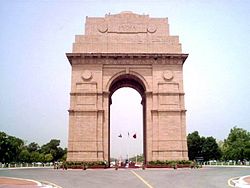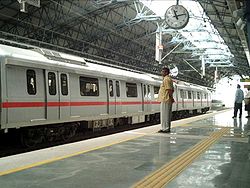Delhi: Difference between revisions
Navidazizi (talk | contribs) m →Famous sites in Delhi: fixing link to Bahá'í House of Worship |
No edit summary |
||
| Line 18: | Line 18: | ||
|- |
|- |
||
|[[Language]] |
|[[Language]] |
||
|[[Urdu]], [[Hindi]], [[Punjabi]] |
|[[Urdu]], [[Hindi]], [[Punjabi]], [[English language|English]] and most other Indian Languages |
||
|- |
|- |
||
|[[Time zone]] |
|[[Time zone]] |
||
Revision as of 19:17, 2 January 2005
You must add a |reason= parameter to this Cleanup template – replace it with {{Cleanup|reason=<Fill reason here>}}, or remove the Cleanup template.

| |
| Classification | National capital territory |
| Country | India |
| State | Delhi |
| District | Delhi District |
| Language | Urdu, Hindi, Punjabi, English and most other Indian Languages |
| Time zone | GMT+5:30 |
| Importance | Capital of India, separate state, Second largest metropolitan city in India, Industrial & IT Hub, Education center par excellence. Seat of government and influence |
| Population |
|
| Literacy Rate |
81.7%[2] |
| Area | 1483 km2 |
| PIN | 110 xxx |
| Chief Minister | Sheila Dixit |
| Ruling Party | Congress |
| Major Political parties | Congress, BJP |
Delhi (दिल्ली or Dillī in Hindi and Bengali and ﻰﻠﮨ ﺩ in Urdu ) along with a few other neighbouring districts forms the 'National Capital Territory' of the Republic of India. It contains the newer city of New Delhi which is no longer a distinguishable urban area, but contains many of the administrative institutions of the national government, and is formally considered the national capital.
It occupies an area of some 1,483 square kilometres (572 square miles) with a population of approximately 14 million. The principal spoken languages are Urdu, Hindi, Punjabi, and English.
Delhi derives its historic importance from its position in northern India, occupying a location between the Aravalli Hills to the southwest and the Yamuna river on whose western banks it stands. This enabled it to dominate the old trade routes from northwest India to the plains of the Ganges.
History
Traditionally, Delhi is said to be the site of Indraprastha, capital of the Pandavas in the Indian epic Mahabharata. A village called Indarpat existed in Delhi until the beginning of the 19th century.
Excavations have unearthed sherds of the grey painted ware (ca. 1000 BC) that some archaeologist associate with the age of the Mahabharata, but no coherent settlement traces have been found. Some locate Indraprastha in the Purana-Qila area.
The earliest architectural relics stem from the Mauryan Period (ca 300 BC), since then, the site has seen continuous settlement. In 1966, an inscription of the Mauryan King Ashoka, 273-236 BC was discovered near Srinivaspuri. The famous wrought iron pilar of Ashoka now to be seen in Qutb Minar was only manufactured in the Gupta-Period (AD 400-600) and transplanted to Delhi at some time in the 10th century. Two sandstone pillars inscribed with the edicts of Ashoka were only later brought to the city by Firuz Shah Tughluq.
In the Prithvirajaraso, the Rajput Anangpal is named as the founder of Delhi. He is supposed to have constructed the Lal-Kot and brought the Iron Pillar to the city. The Rajput period is dated from ca. 900-1200. The name of Dhilli or Dhillika first appears in an inscription from 1170 from Udaipur. By 1316, it may have become the capital of Haryana. After 1206, Delhi was the capital of the Delhi Sultanate (Mamluk dynasty, Khalij dynasty, Tughluq dynasty, Sayyid dynasty and Lodhi dynasty).
The more recent city is believed to be made up of seven succesive cities, the remains of some of which can still be seen on the ground.
- Qila Rai Pithora built by Qutb-ud-din Aibak, near the oldest Rajput settlement in Lal-Kot
- Siri, built by Alauddin Khilji in 1303
- Tughluqabad, built by Ghiyazudin Tughluq (1321-1325).
- Jahanpanah, built by Muhammad bin Tuqhluq (1325-1351)
- Kotla Firoz Shah, built by Firuz Shah Tughluq (1351-1388)
- Purana Qila built by Sher Shah Suri and Dinpanah built by Humayun, both in the same area near the speculated site of the legendary Indra-Prastha (1538-1545)
- Shahjahanabad, built by Shah Jahan from 1638 to 1649, containing the Lal Qila and the Chandni Chowk.
In the mid-seventeenth century, the Mughal Emperor Shah Jahan (1628-1658) built the city that sometimes bears his name (Shahjahanabad), the seventh city of Delhi that is more commonly known as the old city or old Delhi. This city contains a number of significant architectural features; including most notably the Red Fort or Lal Qila. The old city served as the capital of the later Mughal empire from 1638 onwards, when Shah Jahan transferred the capital from Agra. Aurangzeb (1658-1707) crowned himself as emperor in Delhi in 1658 at the Shalinar garden ('Aizzabad-Bagh), a second coronation took place in 1659.

Delhi passed under British control in 1857 after the Sepoy mutiny and after Bahadur Shah Zafar II had been transported to Rangoon and became the Capital of British India in 1911 (formerly Calcutta). In the large scale rebuilding, parts of the Old City were pulled down to provide place for New Delhi.
Economy

Delhi is one of the largest markets in the country despite its being smaller in population than Mumbai. This is primarily because the per capita income in Delhi is much higher than in other cities. Since the 1990s it has become the number one destination for all foreign direct investment. Many multinational companies have set up their headquarters in Delhi and adjoining cities - from Pepsico and Gap Inc to zipper giant, YKK. On the Christmas day of 2002, New Delhi Metro was commenced, running in the urban area. The metro is proposed to be completed in 2022.
The city is served by Indira Gandhi International Airport.
Educational Institutions
Delhi, being the capital of the country attracts students from all over India. It has a number of government and private colleges offering quality education in the fields of science,engineering, medicine, arts, law, management etc. Some prominent educational institutes are :
UNIVERSITIES
- All India Institute of Medical Sciences
- Delhi University
- Guru Gobind Singh University (also known as Indraprastha University)
- Indian Institute of Technology, Delhi
- Indira Gandhi National Open University
- Institute of Chartered Accountants of India
- Jamia Millia Islamia
- Jawaharlal Nehru University
- The Indian Institute of Planning and Management
- Delhi College of Engineering
SCHOOLS
- Air Force Bal Bharti School, Lodi Road
- Delhi Public School, R K Puram
- Kendriya Vidyalaya
- St. Xavier's School, Delhi
- Army Public School
Suburbs around Delhi
Famous sites in Delhi
- Bahá'í House of Worship
- Birla Temple
- Connaught Place
- Deer Park
- Gurdwara Bangla Sahib
- Humayun's Tomb
- India Gate
- International Dolls Museum
- Jama Masjid
- Jantar Mantar
- Kalindi Kunj
- Lodhi Gardens
- Mughal Gardens
- National Museum
- Nehru Planetarium
- Old Fort or the Purana Qila
- Qutab Minar

The Qutb Minar - Rashtrapati Bhawan
- Red Fort, or the Lal Qila
- Safdarjang's Tomb
- Sansad Bhawan or the Parliament House
- Tughlaqabad Fort
- Chandni Chowk
Famous People from Delhi
Newspapers
Markets in Delhi
- Chandni Chowk
- Chhawla
- Connaught Place
- Janpath
- Karol Bagh
- Kamla Nagar
- Khan Market
- Lajpat Nagar Central Market
- Najafgarh
- Palika Bazaar
- South Extension
- Vasant Vihar
- Sarojini Nagar
External links
Literature
- Y. D. Sharma, Delhi and its neighbourhood (New Delhi, Archaeological Survey of India 1990). -Historical architectural remains.
- William Darlymple, The City of Djinns:A Year in Delhi

